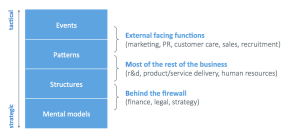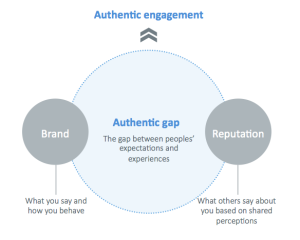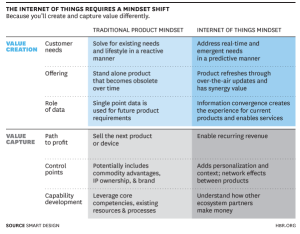 Most Communications professionals spend their time focusing on tactical executions – crafting outputs and pushing them out hoping that that they’ll create outcomes in the form of events or, if they’re lucky, events that generate patterns.
Most Communications professionals spend their time focusing on tactical executions – crafting outputs and pushing them out hoping that that they’ll create outcomes in the form of events or, if they’re lucky, events that generate patterns.
I’ve long argued that the role of Communicators can and should be more strategic. To do that, we need to get involved in the development of structures and new organisational mental models.
Findings from FleishmanHillard’s proprietary research on Authenticity identified 9 key drivers of brand authenticity. Only one of those drivers, Credible Communications, is directly under control of the PR and Marketing function. The rest, which include Innovation, Consistent Performance, Better Value, Customer Care, Care of the Environment, Employee Care, etc are mostly the sort of things that are determined at the Structural or Mental Model levels of the business, long before the PR team find out about it.
 So how does this reinforce my argument that Communications can and should play a more central, strategic role in business? Because we’re the best placed to connect up the dots between what stakeholders want and expect from a brand – through it’s offering but also through it’s behaviour in the World – and what the brand stands for and communicates about itself.
So how does this reinforce my argument that Communications can and should play a more central, strategic role in business? Because we’re the best placed to connect up the dots between what stakeholders want and expect from a brand – through it’s offering but also through it’s behaviour in the World – and what the brand stands for and communicates about itself.
Business models are shifting and approaches that put Communications at the heart of efforts to understand and address that change are the most likely to succeed.
The evidence for this is all around us, from crowd-funding to public-private partnerships to the Internet of Things.
Here’s what Harvard Business Review recently had to say:
“As the Internet of Things (IoT) spreads, the implications for business model innovation are huge. Filling out well-known frameworks and streamlining established business models won’t be enough. To take advantage of new, cloud-based opportunities, today’s companies will need to fundamentally rethink their orthodoxies about value creation and value capture.
Value creation, which involves performing activities that increase the value of a company’s offering and encourage customer willingness to pay, is the heart of any business model. In traditional product companies, creating value meant identifying enduring customer needs and manufacturing well-engineered solutions. Competition was largely feature-versus-feature warfare. And when feature innovation eventually proved to be too incremental, price competition would ensue, and products would become obsolete. Two hundred and fifty years after the start of the Industrial Revolution, this pattern of activity plays out every day, at your local big box electronics retailer or department store.
But in a connected world, products are no longer one-and-done. Thanks to over-the-air updates, new features and functionality can be pushed to the customer on a regular basis. The ability to track products in use makes it possible to respond to customer behavior. And of course, products can now be connected with other products, leading to new analytics and new services for more effective forecasting, process optimization, and customer service experiences. A variety of consumer products and services, from Nest thermostats to Philips Hue lightbulbs to If This Then That (IFTTT), highlight these new possibilities for IoT-based value creation.”
Value creation isn’t just about clever engineering anymore. It’s about creating evidence-based, insights-driven, creatively-led and socially-optimised experiences that are authentic. To do this, brands need to understand audiences, to engage them directly with opportunities to generate shared value, to monitor and react to customer experiences in the real world and in real time. Brands that get this right – brands that realise Communications is the strategic heart of the business of the near future – are likely to thrive.
